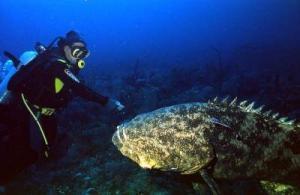Researchers from the University of Hawaii, the Wildlife Conservation Society, Smithsonian Tropical Research Institute, National Marine Fisheries Service and Projecto Meros do Brazil discovered a new species of fish - a grouper that reaches more than six feet in length and can weigh nearly 1,000 pounds. This newly discovered species can be found roaming the tropical reefs of the Eastern Pacific Ocean.

|
| ©Rachel Graham/Wildlife Conservation Society
|
| A new genetic study by the University of Hawaii, the Wildlife Conservation Society, and others has found that there are two species of goliath grouper instead of one.
|
Was the massive fish hiding among the corals and sea grass to evade marine biologists? No, it was just a case of mistaken identity, as explained in a recent genetic study in the journal
Endangered Species Research.
It turns out that goliath in the Atlantic - which inhabit the tropical waters of the Americas and western Africa - are not the same groupers that swim in Pacific waters, even though they look identical.
"For more than a century, ichthyologists have thought that Pacific and Atlantic goliath grouper were the same species, and the argument was settled before the widespread use of genetic techniques. The genetic data were the key to our finding: two species, one on each side of the isthmus.," said Dr. Matthew Craig of the Hawaii Institute of Marine Biology, lead author of the study.